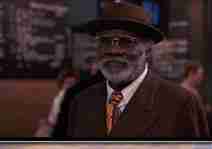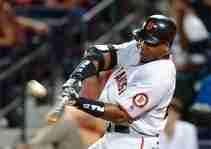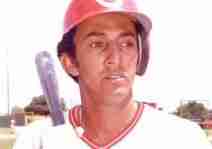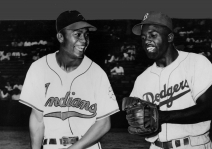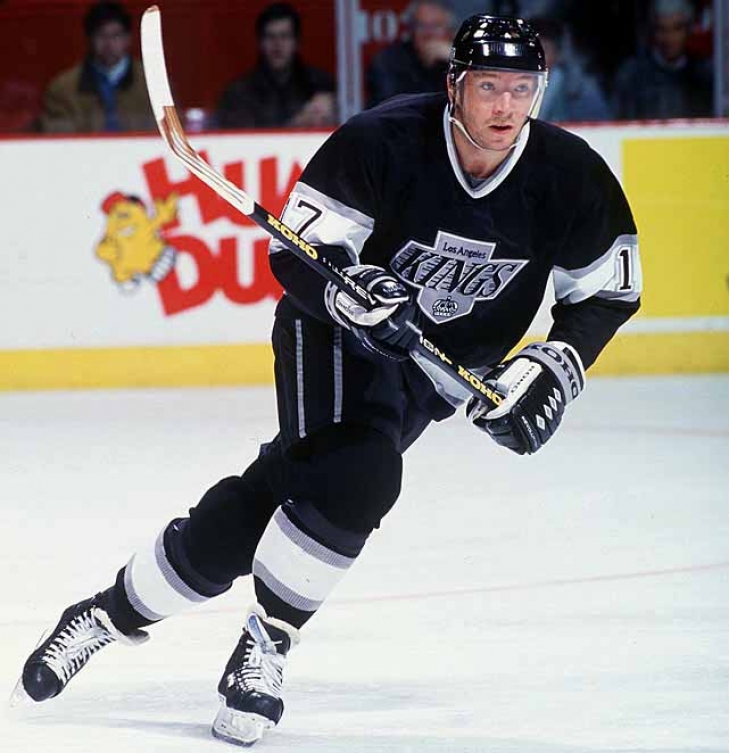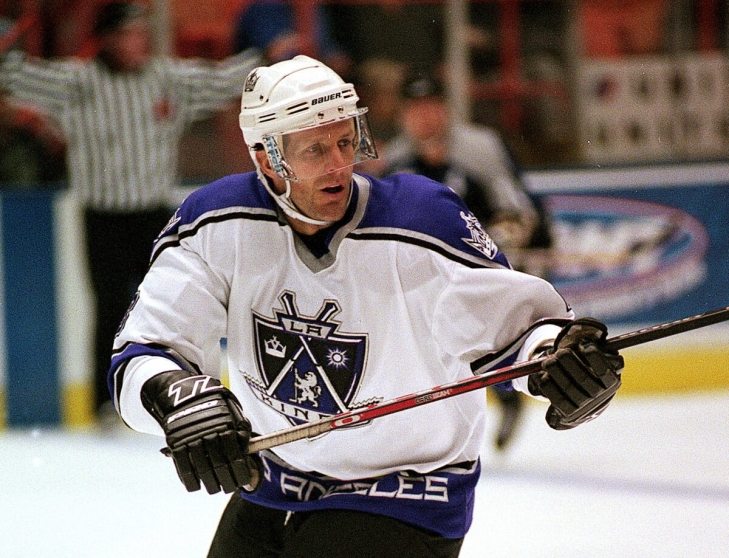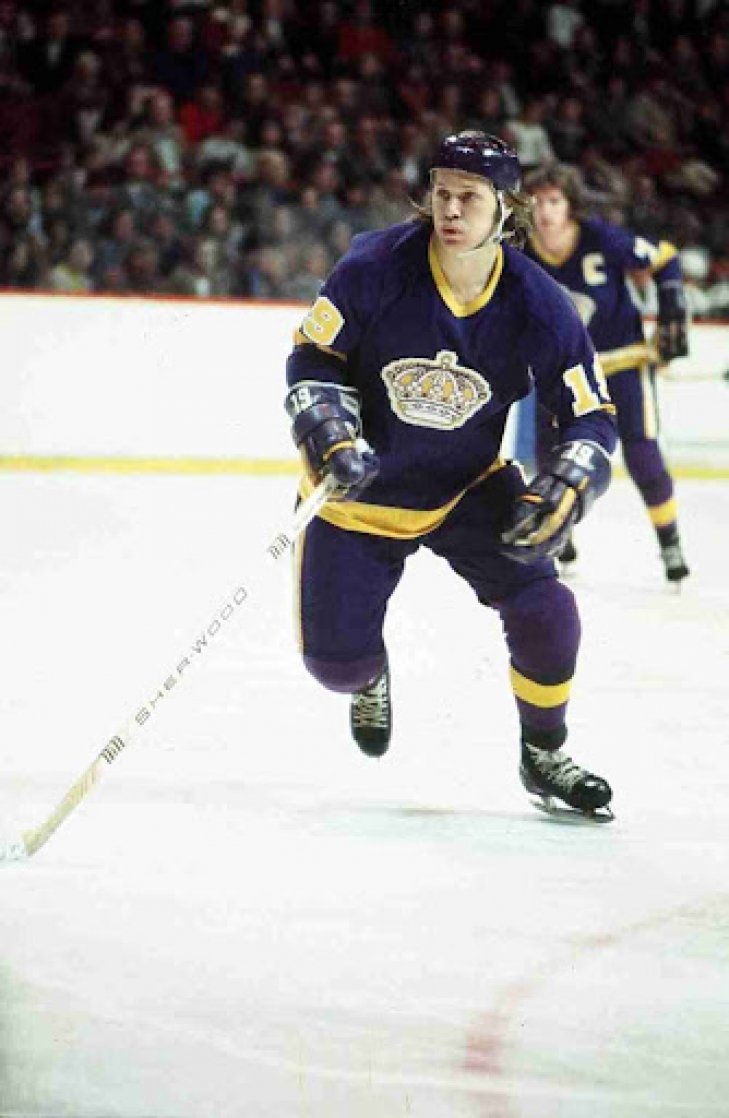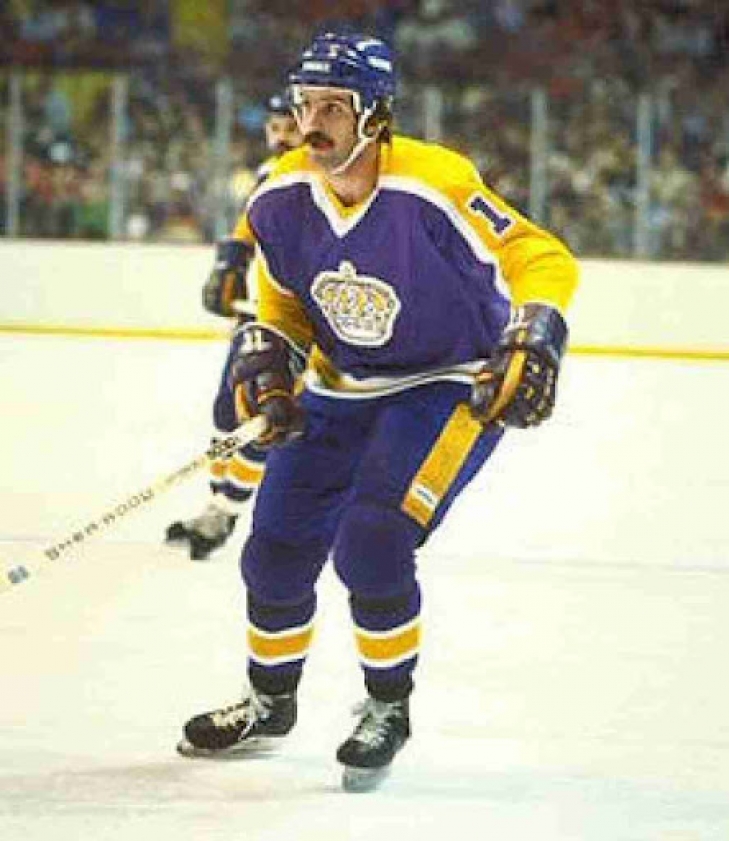Warning: Attempt to read property "params" on null in /home/notinhal/public_html/plugins/k2/k2canonical/k2canonical.php on line 382
36. Jari Kurri
Jari Kurri was one of the legends in Edmonton in the 1980s, winning five Stanley Cups with the Oilers and earning five post-season All-Star Selections. Kurri returned to Europe after the fifth Cup win, but on May 30, 1991, his rights were traded twice, first to Philadelphia, who subsequently dealt him to Los Angeles to reunite him with Wayne Gretzky, and just like that, Kurri was ready to return to North America.
Kurri was not the explosive player he once was but was still an above-average Right Wing. Playing for L.A. for four-and-a-half years, Kurri averaged .89 Points per Game, and was an All-Star in 1993, the same year the Kings went to the Stanley Cup Finals. That year he scored 87 Points, his best with Los Angeles. He left L.A. when he was traded to the New York Rangers, where coincidentally, he again joined a former Oiler legend, Mark Messier.
Kurri was inducted into the Hockey Hall of Fame in 2001.
35. Mattias Norstrom
Mattias Norstrom was traded from the New York Rangers to Los Angeles during his third NHL season as part of an eight-player trade, and the Defenseman would remain with the Kings for 780 Games, making him one of the more tenured players in franchise history.
Norstrom had far more ice time in L.A., and while he was not a blueliner who would rush the offensive end, he could protect his own end of the ice and was so well regarded that he was named an All-Star in both 1999 and 2004. The shutdown defender managed to accumulate 142 Points for Los Angeles before he was traded to Dallas late in the 2006-07 Season.
34. Jaroslav Modry
Jaroslav Modry was traded to Los Angeles late in the 1995/96 season, which was the third team in his young career.
As he did with his previous squads (New Jersey and Ottawa), Modry bounced back and forth between the parent club and the minors, but in 2000, the Czech Defenseman found his game. Modry had a breakout 2001-02 Season, scoring 42 Points and earning a trip to the All-Star Game. He had two more good years for the Kings, producing 38 and 32 Points, respectively, before signing with Atlanta as a Free Agent.
Modry would overall accrue 238 Points as a King.
33. Mario Lessard
Mario Lessard was a late round pick in 1974, and the Goalie would make the Los Angeles Kings roster four years later, where he would become their primary netminder.
The Quebecer held that role for four years, one of them being very good, so good that it is primarily responsible for his high rank. In 1980-81, Lessard led all Goalies in Wins (35), Goalie Point Shares (12.6), and was a Second Team All-Star. Lessard might be best known for a blunder in the 1982 playoffs against Edmonton (he left the net open to trying to beat a Glenn Anderson breakaway), but he had a good run.
Lessard’s play fell off in the 1983-84 season, and he retired shortly after.
31. Bob Berry
The talent-laden Montreal Canadiens had no spot for Bob Berry, a Left Wing who was already in his mid-20’s but unable to appear in more than 2 Games for the Habs. Montreal sold his contract to Los Angeles, allowing Berry an opportunity to play in the NHL.
He responded well to the task, scoring 63 Points in his full-season debut. He slipped the following season (39 Points) but followed that with his best year in hockey, a 36-Goal, 64 Point year, which also saw him go to his first All-Star Game. Berry was an All-Star again in 1974, scoring 56 Points.
Age would catch up to Berry, as he only played three additional years in the NHL but had a respectable 350 Points in 539 Games as a King.
30. Jim Fox
One of the better scorers for the Kings in the 1980s, Jim Fox, is also one of their most forgotten contributors.
The Right Wing had 43 Points as a rookie, which he followed up with back-to-back 68 Point seasons. Fox had 30 Goals in 1981-82 and duplicated that in both 1983-84 and 1984-85, where he increased his Points totals to 72 and 83, respectively. Fox should have been able to improve that as he was only 25 when he had his 83-Point year, but his knees began to become issues.
Fox was held to 39 Games in 1984-85 and missed a handful of games the next two years before he was unable to play the entirety of the 1988-89 campaign. He tried a comeback but had to retire before 30. Fox had 479 Points in his career, all of which was with the Kings.
He would later have a long career with the organization, working as a broadcaster.
32. Mark Hardy
Mark Hardy was one of the better offensive Defenseman for the Los Angeles Kings in the 1980s, debuting for them in 1979-80, the year he was taken in the Second Round.
From 1981-82 to 1984-85, Hardy had at least 39 Points, peaking with a 53-Point performance in the last year of that streak. Hardy remained with the Kings until February of 1988 when he was traded to the Rangers, but he was traded back for their L.A.'s 1993 playoff run. He played one more year before retiring.
Hardy had 303 Points in 616 Games for the Kings, a very good number, but his Plus/Minus -121 for Los Angeles hampers his rank.
29. Larry Murphy
The Hall of Fame career of Larry Murphy began in Los Angeles, the organization that made him the Fourth Overall Pick in 1980.
Murphy made the Kings immediately, scoring 76 Points, and was the runner-up for the Calder, as well as finishing seventh for the Norris. He never had a higher scoring season for Los Angeles but was still a potent performer from the blueline. He had over 60 Points in the next two seasons and might have had another, but he was traded six Games into the 1983/84 campaign to the Washington Capitals. As a King, Murphy had 254 Points with a .86 PPG.
He went on to have three Second Team All-Star campaigns and win four Stanley Cups (two with Pittsburgh and two with Detroit). He entered the Hockey Hall of Fame in 2004.
25. Tyler Toffoli
Tyler Toffoli debuted in the NHL for the team that drafted him, Los Angeles, in the 2012/13 Season for 10 Games, a taste that allowed him to adapt to the speed of the NHL. Toffoli never went back to the minors, and he was capable Center on a second or third line for the Kings for years.
A member of the 2014 Stanley Cup Championship Team, Toffoli led the NHL in Short-Handed Goals with five, and in 2015-16, he led the NHL in Plus/Minus with +35. That season, Toffoli had his best numbers as a King, with 31 Goals and 58 Points. Toffoli had two other years with Los Angeles, where he had at least 47 Points.
Toffoli was traded to Vancouver during the 2020-21 Season, which was his last year under his contract. As a King, he had 290 Points.
28. Tomas Sandstrom
Tomas Sandstrom played the first five-and-a-half years of his NHL career with the New York Rangers before a trade brought him to Los Angeles, a team that was looking for his combination of grit and scoring prowess.
In the early 90s, Scandinavians were not known for their physicality, but Sandstrom could grind as well he could score. The Swedish Right Wing was oft-injured in L.A., but when he did play, he averaged over a Point per Game. His best year as a King was in 1988-89, where he had a career-high 89 Points, and he was electric in the 1993 run to the Stanley Cup Finals, where he scored 25 Points.
Los Angeles traded Sandstrom to Pittsburgh during the 1993-94 Season, and as a King, he would compile 254 Points in 235 Games.
27. Marty McSorley
When the Edmonton Oilers made the biggest trade in hockey, the transaction that sent Wayne Gretzky to Los Angeles, the “Great One” insisted that Marty McSorley would be part of the deal. It was a necessary request, and McSorely was not just his friend but his enforcer and the man who cleared the ice for McSorley's magic.
McSorley was one of hockey’s best pugilists, and he amassed a whopping 1,864 Penalty Minutes in his 472 Games as a King. Gretzky continued to flourish with McSorley watching his back, but McSorely was a decent hockey player in his own right. McSorley averaged .50 Points per Game with Los Angeles and was better at the defensive side than he got credit for. He even led the NHL in Plus/Minus (+48) in 1990-91.
McSorley had two runs in L.A., as he was traded to Pittsburgh in the 1993/94 Season, but was dealt back to the Kings before the next season began. His Kings career ended for good when he was traded to the Rangers in March of 1996.
Sadly, McSorley is best known for swinging his hockey stick at Donald Brashear's head in a game in 2000. Brashear fell and hit his head on the ice, rendering him unconscious. McSorely was suspended for the rest of the year and the full year after that and never played again.
24. Alex Frolov
A First Round Pick from Moscow, Alex Frolov debuted with the Kings two years after he was drafted. The Left Wing had a promising rookie year, finishing eighth in Calder voting with 31 Points, but the Kings brass were hoping for a lot more from the Russian. That is what they got.
Frolov increased his production gradually, going to 48, 54, and 71 Points respectively over the next three years. 71 would be his highest tally, but he had at least 50 Points over the next three years and was an asset to the Kings, especially considering they did not have a lot of scorers on their roster.
He left the Kings for the Rangers in 2010, but a torn ACL ended him there, and he finished his career in Russia. Frolov had 381 Points for Los Angeles.
23. Jake Muzzin
Jake Muzzin had a unique path to the NHL, as despite being drafted By Pittsburgh in 2007, the OHL Defenseman was not signed. Muzzin reentered the draft in 2009, but this time no NHL took him. Muzzin was eligible to play one more year in the OHL, and he maximized the opportunity, winning the OHL Defenseman of the Year. The Kings took notice, signed Muzzin, who made the team.
Over the first two seasons, Muzzin mainly played in the AHL over the first two seasons, though he was on the roster (though he did not play) when the Kings captured the 2012 Stanley Cup. Muzzin was in the NHL to stay in 2012, gradually gaining more playing time with each playing year. Helping the Kings win their second Stanley Cup in 2014, Muzzin would have at least 40 Points in three of the following four seasons, and he was arguably one of the better players for Los Angeles in the mid-10s.
The struggling Kings traded Muzzin to Toronto in 2019, leaving the Kings with 213 Points.
22. Alec Martinez
Alec Martinez played his college hockey in the MAC with Miami (of Ohio), doing well enough to transfer his skills to the Los Angeles Kings early in the 4th Round of the 2007 Draft.
Martinez first made the Kings in 2009-10, and in the following year, his AHL days were permanently in his rearview mirror. A clean player who could be used well on the power play, Martinez had a five-year run of 20-plus Point seasons, two of which exceeded the 30-Point mark. Martinez also played a part in the Kings two Stanley Cups in 2012 and 2014.
Martinez played for Los Angeles for 11 years, traded to Vegas early in the 2019-20 Season. The Defenseman would score 198 Points as a King.
21. Mike Murphy
After two years in St. Louis and a year-and-a-half with the New York Rangers, Mike Murphy was traded to Los Angeles, where he played ten years and had the best run of his career.
Playing at Right Wing, Murphy had back-to-back 68 Point years (1974-75 & 1975-76) and was one of the few offensive threats that the Kings had at the time. This season was his top output, but not the end for Murphy, who had two more years where he had at least 55 Points, and as Los Angeles acquired and developed more offensive stars, Murphy provided depth and grit on lower lines.
Age and injuries caught up to Murphy, who retired after the 1982-83 Season. He had 457 Points in 673 Games for Los Angeles.
20. Bob Murdoch
Bob Murdoch first signed with the Montreal Canadiens in 1970, and though he was traded to Minnesota, he was reclaimed by the Habs in the 1971 Intra-League Draft, the deep defensive corps that Montreal had, prevented Murdoch from being a potential star for that team. As Murdoch was expendable, Montreal traded him to Los Angeles, where he had his chance to shine.
Murdoch was a King for five-and-a-half years, where he grinded and playmaked better than any other Defenseman for Los Angeles in the 1970s. He would have his best run in hockey with L.A., where as a King, he had three straight 30-plus Point years. Murdoch’s best season was in 1974-75, where he was named an All-Star with a career-high 42 Points with a third-place finish in Defensive Point Shares. Two years later, Murdoch was ninth in Defensive Point Shares.
Murdoch left Los Angeles in early 1979 when he was traded to the struggling Atlanta Flames. He might not have been a star in the NHL or even in Los Angeles, but Murdoch was an underappreciated player in the Kings canon, who had 171 Points with Los Angeles.
17. Ziggy Palffy
Ziggy Palffy played the first six years of his career with the New York Islanders, where he had a three-year run of at least 87 Points. The Isles dealt Palffy to the Kings in a large transaction in the summer of 2000, and Palffy achieved approximately the same level of success in LaLa Land.
The Right Wing had three straight 30-plus Goal years for Los Angeles (2000-01 to 2002-03), his best year being 2000-01 with 89 Points and a fifth-place finish for the Lady Byng. Twice an All-Star as a King, Palffy scored 340 Points in his five seasons in Los Angeles, nine more than he had with the Islanders. He also had a Plus/Minus of +85 in L.A.
16. Steve Duchesne
You don’t expect an undrafted Canadian player to do much in the National Hockey League, but Steve Duchesne had other ideas.
Duchesne signed with Los Angeles in 1984 and made the Kings two years later after two seasons in the Minors. In his first year in the NHL, the Defenseman surprised the hockey world with a 38 Point year and an All-Rookie Selection. Duchesne progressed into one of the better offensive Defenseman of the game, and he secured 55 Points as a sophomore, which he grew to 75 the year after, which netted him his first All-Star Game appearance.
Duchesne was an All-Star again in 1990, scoring 62 Points, a mark he would reach the following year again. The Kings elected to retool, and he was traded to Los Angeles in a transaction that reunited Wayne Gretzky and Jari Kurri. Duchesne returned as a Free Agent in 1998, but would not complete the season, as he was traded to Philadelphia again.
As a King, Duchesne played 442 Games, scoring 315 Points with a Plus/Minus of +50.
15. Butch Goring
Bouncing between the minors and the Kings through his first two seasons, Goring showed a lot of potential in this period, and in 1971, his days in the secondary league were over.
Goring scored 50 Points in 1971-72, increasing it to 59 and 61 the next two years with a 60-Point year as the follow-up. Even in the 1970s, Goring was small, listed at 5' 9", and 170 pounds, but likely was smaller than that. Goring took his game to a higher level with the increased ice time, alternating 70-plus and 80-plus Point years over the next five years. The hockey writers noticed the cleanliness of his play, as it took until 1978-79 before he had double digits in Penalty Minutes. Goring won the Lady Byng Trophy in 1978 and was also awarded the Bill Masterton Trophy, a testament to his high output despite his small frame.
Goring was traded to the New York Islanders late in the 1979/80 Season, where he proved to be the final piece of the puzzle for the team that won four straight Stanley Cups.
With the Kings, Goring scored 659 Points with only 66 Penalty Minutes in 736 Games.
14. Charlie Simmer
Charlie Simmer began his career with the California Seals, and after a brief period with the Cleveland Barons, he found himself with Los Angeles. After playing most of the 1977-78 Season in the Minors, Simmer split the following year with Springfield (AHL) and L.A., but the Left Wing established himself with 48 Points in 37 Games, and he was never demoted again.
Simmer was now on a line with Marcel Dionne and Dave Taylor, the famed "Triple Crown Line." In 1979-80, Simmer led the NHL in Goals with 56 and Power Play Goals (21). He was named a First Team All-Star and was so again in the year after when he repeated his light-lamping output with 56.
Simmer could not reproduce the magic of those two years, though he did have an 80 Point campaign in 1982-83 with a 92 Point follow-up in 1983-84. The Kings traded Simmer to the Bruins very early in the 1984-85 Season, and Simmer left the L.A. with 466 Points in 384 Games.


